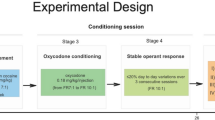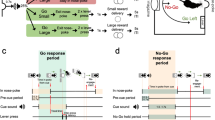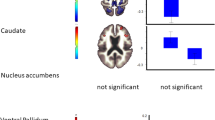Abstract
Dopamine is a critical mediator of instrumental reward seeking behavior and appears to have a particularly important role in motivating actions that require considerable effort. As with rewards, response costs can be evaluated in both absolute and relative terms. The current study investigated whether the extent to which instrumental performance is dependent on dopamine transmission is influenced by relative or absolute response cost. Three groups of rats were rewarded for lever pressing on different fixed ratio (FR) schedules that required 1 (FR-1), 10 (FR-10), or 20 (FR-20) presses for each food reward. Rats were then injected systemically with flupentixol, a dopamine receptor antagonist, or vehicle before testing all groups on an intermediate-cost (FR-10) schedule, such that only the relative cost of responding differed across groups. Rats experiencing an upshift in cost (group FR-1/FR-10) showed greater response suppression following flupentixol administration than rats experiencing no shift in cost (group FR-10/FR-10), whereas flupentixol treatment had no effect on rats experiencing a downshift in cost (group FR-20/FR-10). A second round of flupentixol tests was conducted using the rats’ maintenance schedules, such that only absolute response costs differed across groups. Here, the pattern was reversed among the groups, in line with previous reports. Specifically, flupentixol had a stronger suppressive effect in group FR-20/FR-20 than in group FR-10/FR-10, and had no detectable effect in group FR-1/FR-1. These findings suggest that response costs are evaluated in both absolute and relative terms and that dopamine has a role in overcoming both kinds of cost.
Similar content being viewed by others
Log in or create a free account to read this content
Gain free access to this article, as well as selected content from this journal and more on nature.com
or
References
Aberman JE, Salamone JD (1999). Nucleus accumbens dopamine depletions make rats more sensitive to high ratio requirements but do not impair primary food reinforcement. Neuroscience 92: 545–552.
Ahn S, Phillips AG (2007). Dopamine efflux in the nucleus accumbens during within-session extinction, outcome-dependent, and habit-based instrumental responding for food reward. Psychopharmacology 191: 641–651.
Beeler JA, Daw N, Frazier CR, Zhuang X (2010). Tonic dopamine modulates exploitation of reward learning. Front Behav Neurosci 4: 170.
Berridge KC, Robinson TE (2003). Parsing reward. Trends Neurosci 26: 507–513.
Choi WY, Balsam PD, Horvitz JC (2005). Extended habit training reduces dopamine mediation of appetitive response expression. J Neurosci 25: 6729–6733.
Cousins MS, Salamone JD (1994). Nucleus accumbens dopamine depletions in rats affect relative response allocation in a novel cost/benefit procedure. Pharmacol Biochem Behav 49: 85–91.
Day JJ, Jones JL, Wightman RM, Carelli RM (2010). Phasic nucleus accumbens dopamine release encodes effort- and delay-related costs. Biol Psychiatry 68: 306–309.
Denk F, Walton ME, Jennings KA, Sharp T, Rushworth MF, Bannerman DM (2005). Differential involvement of serotonin and dopamine systems in cost-benefit decisions about delay or effort. Psychopharmacology 179: 587–596.
Dickinson A, Smith J, Mirenowicz J (2000). Dissociation of Pavlovian and instrumental incentive learning under dopamine antagonists. Behav Neurosci 114: 468–483.
Floresco SB, Tse MT, Ghods-Sharifi S (2008a). Dopaminergic and glutamatergic regulation of effort- and delay-based decision making. Neuropsychopharmacology 33: 1966–1979.
Floresco SB, St Onge JR, Ghods-Sharifi S, Winstanley CA (2008b). Cortico-limbic-striatal circuits subserving different forms of cost-benefit decision making. Cogn Affect Behav Neurosci 8: 375–389.
Gan JO, Walton ME, Phillips PE (2010). Dissociable cost and benefit encoding of future rewards by mesolimbic dopamine. Nat Neurosci 13: 25–27.
Glimcher PW (2011). Understanding dopamine and reinforcement learning: the dopamine reward prediction error hypothesis. Proc Natl Acad Sci USA 108 (Suppl 3): 15647–15654.
Hamill S, Trevitt JT, Nowend KL, Carlson BB, Salamone JD (1999). Nucleus accumbens dopamine depletions and time-constrained progressive ratio performance: effects of different ratio requirements. Pharmacol Biochem Behav 64: 21–27.
Lex A, Hauber W (2008). Dopamine D1 and D2 receptors in the nucleus accumbens core and shell mediate Pavlovian-instrumental transfer. Learn Mem 15: 483–491.
Mingote S, Weber SM, Ishiwari K, Correa M, Salamone JD (2005). Ratio and time requirements on operant schedules: effort-related effects of nucleus accumbens dopamine depletions. Eur J Neurosci 21: 1749–1757.
Nasrallah NA, Clark JJ, Collins AL, Akers CA, Phillips PE, Bernstein IL (2011). Risk preference following adolescent alcohol use is associated with corrupted encoding of costs but not rewards by mesolimbic dopamine. Proc Natl Acad Sci USA 108: 5466–5471.
Nicola SM (2010). The flexible approach hypothesis: unification of effort and cue-responding hypotheses for the role of nucleus accumbens dopamine in the activation of reward-seeking behavior. J Neurosci 30: 16585–16600.
Niv Y, Daw ND, Joel D, Dayan P (2007). Tonic dopamine: opportunity costs and the control of response vigor. Psychopharmacology 191: 507–520.
Ostlund SB, Maidment NT (2012). Dopamine receptor blockade attenuates the general incentive motivational effects of noncontingently delivered rewards and reward-paired cues without affecting their ability to bias action selection. Neuropsychopharmacology 37: 508–519.
Ostlund SB, Wassum KM, Murphy NP, Balleine BW, Maidment NT (2011). Extracellular dopamine levels in striatal subregions track shifts in motivation and response cost during instrumental conditioning. J Neurosci 31: 200–207.
Phillips PE, Walton ME, Jhou TC (2007). Calculating utility: preclinical evidence for cost-benefit analysis by mesolimbic dopamine. Psychopharmacology 191: 483–495.
Robbins TW, Granon S, Muir JL, Durantou F, Harrison A, Everitt BJ (1998). Neural systems underlying arousal and attention. Implications for drug abuse. Ann N Y Acad Sci 846: 222–237.
Salamone JD, Correa M, Farrar A, Mingote SM (2007). Effort-related functions of nucleus accumbens dopamine and associated forebrain circuits. Psychopharmacology 191: 461–482.
Salamone JD, Cousins MS, Bucher S (1994a). Anhedonia or anergia? Effects of haloperidol and nucleus accumbens dopamine depletion on instrumental response selection in a T-maze cost/benefit procedure. Behav Brain Res 65: 221–229.
Salamone JD, Cousins MS, McCullough LD, Carriero DL, Berkowitz RJ (1994b). Nucleus accumbens dopamine release increases during instrumental lever pressing for food but not free food consumption. Pharmacol Biochem Behav 49: 25–31.
Salamone JD, Kurth PA, McCullough LD, Sokolowski JD, Cousins MS (1993a). The role of brain dopamine in response initiation: effects of haloperidol and regionally specific dopamine depletions on the local rate of instrumental responding. Brain Res 628: 218–226.
Salamone JD, Mahan K, Rogers S (1993b). Ventrolateral striatal dopamine depletions impair feeding and food handling in rats. Pharmacol Biochem Behav 44: 605–610.
Salamone JD, Steinpreis RE, McCullough LD, Smith P, Grebel D, Mahan K (1991). Haloperidol and nucleus accumbens dopamine depletion suppress lever pressing for food but increase free food consumption in a novel food choice procedure. Psychopharmacology 104: 515–521.
Salamone JD, Wisniecki A, Carlson BB, Correa M (2001). Nucleus accumbens dopamine depletions make animals highly sensitive to high fixed ratio requirements but do not impair primary food reinforcement. Neuroscience 105: 863–870.
Satoh T, Nakai S, Sato T, Kimura M (2003). Correlated coding of motivation and outcome of decision by dopamine neurons. J Neurosci 23: 9913–9923.
Schultz W (2010). Dopamine signals for reward value and risk: basic and recent data. Behav Brain Funct 6: 24.
Segovia KN, Correa M, Salamone JD (2011). Slow phasic changes in nucleus accumbens dopamine release during fixed ratio acquisition: a microdialysis study. Neuroscience 196: 178–188.
Sokolowski JD, Conlan AN, Salamone JD (1998). A microdialysis study of nucleus accumbens core and shell dopamine during operant responding in the rat. Neuroscience 86: 1001–1009.
Walton ME, Kennerley SW, Bannerman DM, Phillips PE, Rushworth MF (2006). Weighing up the benefits of work: behavioral and neural analyses of effort-related decision making. Neural Netw 19: 1302–1314.
Wanat MJ, Kuhnen CM, Phillips PE (2010). Delays conferred by escalating costs modulate dopamine release to rewards but not their predictors. J Neurosci 30: 12020–12027.
Wassum KM, Ostlund SB, Balleine BW, Maidment NT (2011). Differential dependence of Pavlovian incentive motivation and instrumental incentive learning processes on dopamine signaling. Learn Mem 18: 475–483.
Wassum KM, Ostlund SB, Maidment NT (2012). Phasic mesolimbic dopamine signaling precedes and predicts performance of a self-initiated action sequence task. Biol Psychiatry 71: 846–854.
Wise RA (2008). Dopamine and reward: the anhedonia hypothesis 30 years on. Neurotox Res 14: 169–183.
Zhang M, Balmadrid C, Kelley AE (2003). Nucleus accumbens opioid, GABaergic, and dopaminergic modulation of palatable food motivation: contrasting effects revealed by a progressive ratio study in the rat. Behav Neurosci 117: 202–211.
Acknowledgements
This work was supported by grant DA09359 and DA05010 from NIDA to NTM and grant DA029035 to SBO.
Author information
Authors and Affiliations
Corresponding author
Ethics declarations
Competing interests
The authors declare no conflict of interest.
Rights and permissions
About this article
Cite this article
Ostlund, S., Kosheleff, A. & Maidment, N. Relative Response Cost Determines the Sensitivity of Instrumental Reward Seeking to Dopamine Receptor Blockade. Neuropsychopharmacol 37, 2653–2660 (2012). https://doi.org/10.1038/npp.2012.129
Received:
Revised:
Accepted:
Published:
Issue date:
DOI: https://doi.org/10.1038/npp.2012.129
Keywords
This article is cited by
-
Dopaminergic modulation of reward discounting in healthy rats: a systematic review and meta-analysis
Psychopharmacology (2021)
-
To continue or not to continue? Antipsychotic medication maintenance versus dose-reduction/discontinuation in first episode psychosis: HAMLETT, a pragmatic multicenter single-blind randomized controlled trial
Trials (2020)
-
Missing motoric manipulations: rethinking the imaging of the ventral striatum and dopamine in human reward
Brain Imaging and Behavior (2019)



